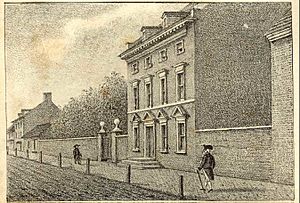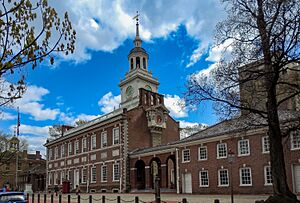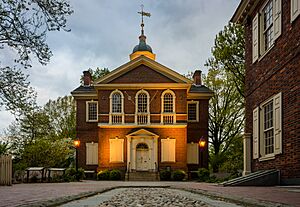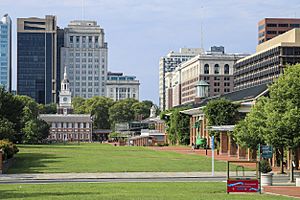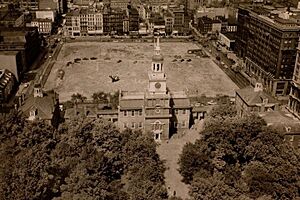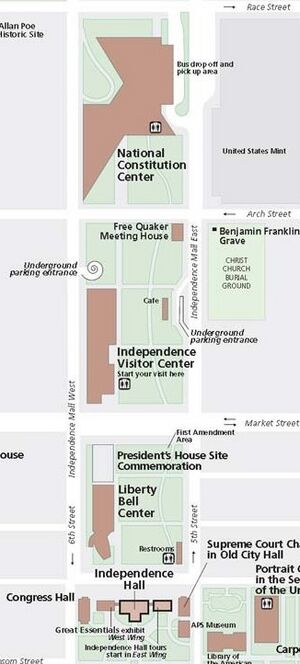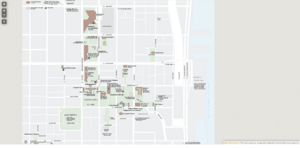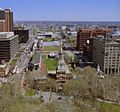Independence National Historical Park facts for kids
Quick facts for kids Independence National Historical Park |
|
|---|---|
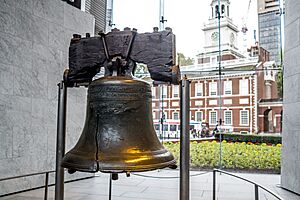
The Liberty Bell (foreground) and Independence Hall (background) at Independence National Historical Park
|
|
| Location | 143 S. 3rd Street, Philadelphia, Pennsylvania, U.S. |
| Area | 55.42 acres (22.43 ha) |
| Architect | William Strickland, et al. |
| Architectural style(s) | Colonial, Georgian, and Federal |
| Visitors | 3,572,770 (in 2011) |
| Governing body | National Park Service |
| Designated | October 15, 1966 |
| Reference no. | 66000683 |
| Designated | June 28, 1948 |
| Lua error in Module:Location_map at line 420: attempt to index field 'wikibase' (a nil value). | |
Independence National Historical Park is a special place in Philadelphia, Pennsylvania. It protects many important sites connected to the American Revolution and the start of the United States. The National Park Service takes care of this park, which is about 55 acres (22 hectares). It includes many famous historical spots in Philadelphia's Old City and Society Hill areas. People often call it "America's most historic square mile" because there are so many important landmarks here.
The most important building in the park is Independence Hall. Here, America's Founding Fathers discussed and approved the Declaration of Independence and the United States Constitution in the late 1700s. Independence Hall was where the Second Continental Congress met from 1775 to 1783. It was also the site of the Constitutional Convention in 1787. Nearby, you'll find Carpenters' Hall, where the First Continental Congress met in 1774. Congress Hall was where the United States Congress met in the 1790s, before Washington, D.C. became the capital.
Just across from Independence Hall, you can see the Liberty Bell. This famous bell is a powerful symbol of American freedom. It is on display at the Liberty Bell Center. The park also has other old buildings. These include the First Bank of the United States, which was the country's very first national bank. There's also the Second Bank of the United States. You can also visit City Tavern, a rebuilt colonial restaurant. It was a popular spot for the leaders of the time. John Adams even called it the best tavern in America!
Many of the park's historic buildings are found in four special blocks. These are located between Chestnut, Walnut, 2nd, and 6th streets. The park also features Franklin Court. This is where Benjamin Franklin's home used to be. Today, it has a museum about Franklin and the United States Postal Service Museum. (Benjamin Franklin was the first Postmaster General for the new government!) North of Independence Hall are three more blocks called Independence Mall. Here you'll find the Liberty Bell Center, the National Constitution Center, and the Independence Visitor Center. This area also marks where the President's House once stood. The park even displays old items like the Syng inkstand. This inkstand was used when the Declaration and Constitution were signed.
Contents
A Look Back in Time
The Road to Independence
After some unfair laws, called the Intolerable Acts, were passed, leaders from the colonies met. This was the First Continental Congress. They gathered at Carpenters' Hall in Philadelphia in the fall of 1774. They decided to stop buying British goods. They also planned for a Second Continental Congress.
The Second Continental Congress met in May 1775. This was after the first battles of the American Revolutionary War at Lexington and Concord. They met at the Pennsylvania State House, now known as Independence Hall. The Congress tried to make peace with King George III. They sent a letter, the Olive Branch Petition, asking him to stop the fighting. But the King refused their request.
By early 1776, Britain had blocked American ports. This felt like a declaration of war. The colonies realized they needed to declare independence. On June 11, a group called the Committee of Five was chosen. It included John Adams, Benjamin Franklin, and Thomas Jefferson. Their job was to write the Declaration of Independence. On July 4, the Congress officially approved the Declaration. This was the moment the United States of America was born! Many believe the Liberty Bell rang on July 8 to celebrate this big news.
Creating the U.S. Constitution
After the war, the first government was weak. It operated under the Articles of Confederation. So, in 1787, leaders met again in Philadelphia. This meeting was called the Constitutional Convention. They met at the Pennsylvania State House to create a stronger government.
It was a challenging meeting with many different ideas. But the delegates worked together to create the United States Constitution. It was a "bundle of compromises." For example, James Madison suggested the Virginia Plan. This plan gave states more power based on their population. Larger states liked this idea. But smaller states worried they would lose power.
Then, William Paterson proposed the New Jersey Plan. This plan said every state should have one vote, no matter its size. To solve this, Roger Sherman came up with the Connecticut Compromise. This created two parts of Congress: one with votes based on population, and one with equal votes for each state. This important compromise passed by just one vote! They also made other agreements on tough issues to finish the Constitution.
Philadelphia: An Early Capital
For a time, Philadelphia was the temporary capital of the United States. This happened from 1790 to 1800. During these years, Congress Hall was where the United States Congress met. The House of Representatives met downstairs, and the Senate met upstairs. Many important things happened here. Three new states joined the country: Vermont, Kentucky, and Tennessee. The Bill of Rights was also added to the Constitution. Both George Washington and John Adams had their presidential ceremonies here.
The President's House was where President Washington lived and worked. President Adams also lived there after Washington. Important laws were signed here during this time. The Supreme Court also met in Old City Hall nearby.
Even though Philadelphia tried to stay the capital, the government moved. On May 14, 1800, the federal government moved to its new permanent home: Washington, D.C..
Independence Hall After the Capital Moved
After the federal government left, Independence Hall was still used. The state government moved to Harrisburg in 1812. For a while, the State of Pennsylvania thought about selling or even tearing down Independence Hall.
But the City of Philadelphia bought the buildings in 1818. They used them for city offices. Later, in 1852, the Liberty Bell was moved from its tower. It was put on display inside Independence Hall. The Liberty Bell traveled for special events until 1915. After that, the city decided it should stay in Philadelphia.
The Park's Journey
The idea for a park around Independence Hall started in 1915. Architects wanted to create a beautiful setting for the historic building. They also wanted to protect it from fire and reduce crowded areas. This idea grew stronger in the 1920s and 1930s. People felt more patriotic during the American Sesqui-Centennial in 1926. World War II also made people want to protect national treasures even more.
On June 28, 1948, Congress approved creating Independence National Historical Park. It officially opened on July 4, 1956. The park was added to the National Register of Historic Places in 1966. In 1979, Independence Hall became a UNESCO World Heritage Site. This means it's recognized as important to everyone in the world.
How the Park is Managed
The National Park Service manages and protects Independence National Historical Park. They work to keep the historic buildings, old sites, and landscapes safe. They also care for about 1.5 million historical items within the park. In 2003, a lot of work focused on repairing and improving the park's buildings and grounds.
The Independence Visitor Center helps visitors learn about the park and Philadelphia. It's a large building that opened in 2001. Many groups worked together to fund its construction. The National Park Service has many employees who work to keep the park running smoothly.
Independence Mall: A Special Area
Independence Mall is a three-block area north of Independence Hall. It's a key part of Independence National Historical Park. Here you'll find several important places.
On the Mall, you can visit the National Constitution Center. There's also the Independence Visitor Center and the Free Quaker Meetinghouse. The President's House Memorial and the Liberty Bell Center are also here. There are public restrooms and a "Peoples' Plaza" for gatherings.
Many other interesting buildings surround the Mall. These include Congress Hall, Independence Hall, and Old City Hall. You can also see the Philadelphia Mint and the Federal Reserve Bank of Philadelphia.
How Independence Mall Was Planned
The idea for a park around Independence Hall began in 1935. An architect named Roy F. Larson first imagined Independence Mall in 1937. He wanted a large mall that would stretch for five blocks. This idea was strongly supported by groups like the Independence Hall Association.
In 1947, a national park was being created around Independence Hall. Judge Edwin O. Lewis suggested the federal government buy the three blocks north of the historic building. The National Park Service (NPS) was only interested in one block. So, Lewis convinced Pennsylvania to build the three-block mall as a state park.
Independence Mall State Park was created in the 1950s. The plan was for the land to eventually go to the NPS. Many old buildings were bought and torn down to make space for the mall. People thought these buildings didn't fit the historic feel of the area. One important site cleared was the President's House, where George Washington and John Adams lived.
By 1959, only the Free Quaker Meetinghouse remained. It was moved to its current spot in 1961 to make way for a wider street. The first block of the mall was finished in 1954. It featured a central lawn with trees and walkways. The northernmost block was designed by Dan Kiley. His 1963 plan used fountains and many honey locust trees.
The National Park Service Takes Over
Independence National Historical Park was created in 1948. When it opened in 1956, it didn't include the Mall. In 1972, the Mall was given to the NPS. By 1974, the NPS officially owned and operated the entire Mall.
Before 1976, the Liberty Bell was inside Independence Hall. For the Bicentennial celebration, it was decided to move the bell. A new glass and steel building, the Liberty Bell Pavilion, was built. The bell moved there on January 1, 1976. This was its home until October 9, 2003.
Modern Updates and Renovations
In 1997, the NPS announced a plan to redesign Independence Mall. This plan included new public buildings. Most older structures were removed, except for the Free Quaker Meetinghouse. The new design focused buildings along 6th Street. Smaller parks with trees and seating were added along 5th Street.
The Independence Visitor Center opened in November 2001. The National Constitution Center opened in July 2003. The Liberty Bell moved into the Liberty Bell Center in October 2003. The old Liberty Bell Pavilion was taken down in 2006. New exhibits now tell a broader story, including about slavery and its end in U.S. history. A memorial at 6th and Market Streets marks the site of the former President's House. It honors the enslaved people who worked there.
In January 2024, the NPS announced many renovations. These projects are currently underway and expected to be completed by 2026. This is in time for the 250th birthday of the United States. The work includes fixing roofs and updating heating systems. It also involves creating a new public square. The park is also updating how it tells the story of the nation's founding. Major projects include renovating the First Bank of the United States, the Declaration House, Welcome Park, Carpenters' Hall, and the West Wing of Independence Hall.
Other Park Sites to Explore

Independence National Historical Park includes many historic places:
- Bishop White House
- Carpenters' Hall
- Christ Church
- City Tavern
- Congress Hall
- Declaration (Jacob Graff) House
- Dolley Todd House
- Franklin Court and Benjamin Franklin Museum
- First Bank of the United States
- Free Quaker Meeting House
- Independence Hall
- Independence Visitor Center
- Liberty Bell Center
- Merchants' Exchange Building
- Mikveh Israel Cemetery
- New Hall Military Museum
- Old City Hall, where the Supreme Court met
- President's House
- Second Bank of the United States
- Thomas Bond House
- Washington Square and the Tomb of the Unknown Revolutionary War Soldier
- Welcome Park
Other NPS sites connected to Independence NHP, but located outside its main area, include:
- Benjamin Franklin National Memorial
- Edgar Allan Poe National Historic Site
- Germantown White House
- Gloria Dei (Old Swedes') Church National Historic Site
- Thaddeus Kosciuszko National Memorial
Gallery
-
Independence Visitor Center, opened 2001
-
National Constitution Center, opened 2003
See also



